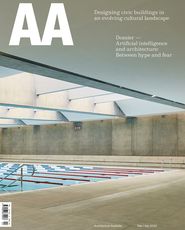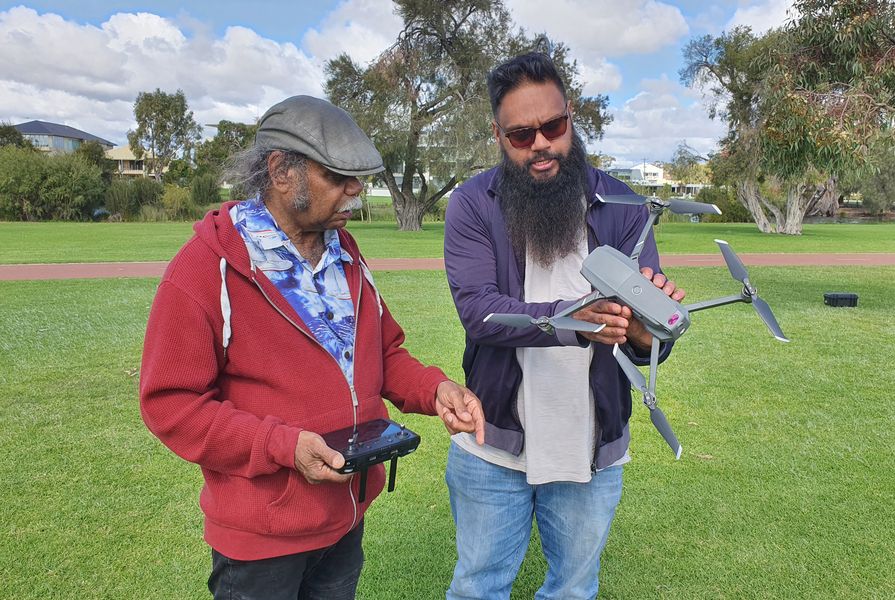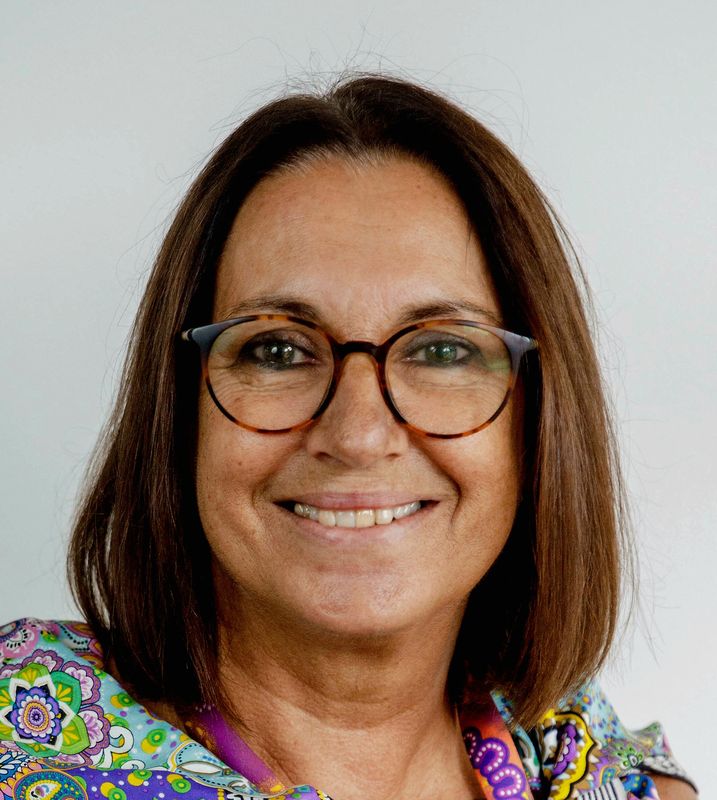Researcher Susan Beetson believes that the use of emerging technologies to digitize cultural Knowledges will empower First Nations communities in built-environment design and beyond. Architecture Media associate editor Georgia Birks speaks with Beetson about the implementation and impacts of these technologies on First Nations communities.
Georgia Birks: Can you share a brief outline of the networking tool you’re working on with Ballardong/Whadjuk and Ngemba community members?
Susan Beetson: The Elders I work with want to create an opportunity for Traditional Custodians and our communities to digitize our Knowledges to retain authority and maintain custodianship.
We want to create opportunities for us [First Nations peoples] to recognize our own cultural health. By cultural health, I mean what we as a community know about our Knowledges, our Country, our people, and our culture. We thought the best way to do that was to create Culture Hubs, where we digitize our Knowledges both in a digital storage place and on an entrepreneurial platform. Community members store digitized artefacts or Knowledges on this platform and a webserver allows the public to view versions of those Knowledges via the internet. Individual community members can market their skills and sell artefacts. Elders can create and monetize reports based on government agency and research requirements, benefitting the entire community. Elders and community members can also partner with First Nations and Western scientists and technologies to enquire into the deeply held insights of Indigenous Knowledges that have the potential to contribute to local, national, and global solutions, initiatives and innovations. This way, First Nations youth grow up immersed in both culture and technology, seeing their Elders respected and their Knowledges valued.
Susan Beetson is a Ngemba Wayilwan computer science researcher and educator in interactive technologies at the University of Queensland. Her research centres on Aboriginal design methods in human–computer interaction.
Image: Supplied
GB: In your current research, you outline that kinship lore is critical for the development of digital platforms. Can you expand on this? What are your thoughts on how to manage kinship intellectual property in the digital world?
SB: In the design of each Culture Hub, there’s a lot to be talked through around intellectual property. We decided that kinship lore aligns the rights and custodianship of the Knowledges to the Knowledge holders. (I always say “Knowledge holders” because I think it’s our place to hold onto Knowledges – not to keep them, but to hold onto them.) So, not all Knowledges are community Knowledges, and it is the Knowledge holder who determines that, in counsel with Elders. To encourage individual Knowledge holders to digitize and store in the Culture Hub to date, Elders and community agree that Elder counsel with individuals has confidently determined that some Knowledges are Kin Knowledges and are not to be shared among community. In these cases, only the individual’s kinship line has access to the Knowledges.
Machine learning (ML) can recognize kinship lines and descendants of Knowledge holders quickly and reliably. ML is an application of artificial intelligence (AI) that uses algorithms and data to teach a machine to learn autonomously over time. AI makes it possible for a machine to make sense of and reason as humans do.
To recognize kinship lines, ML is dependent on the algorithms and on the input of reliable lineage data by individuals. This is why cultural validation is necessary to ensure cultural integrity throughout the Culture Hub. We create moments where the AI algorithms cease and, instead, input by Elders is required. These are triggers that allow Elders to question the results. Now, that’s fairly consistent with Western ways of doing things, in terms of getting humans to intervene. But cultural validation is very structured in the way that Elders ask questions. Where Western systems use reductionist methods, Indigenous Knowledges capture a broad view that questions more deeply and broadly.
While designing the system, we recognized that the way we [First Nation peoples] archive entities is different to Western archival processes. The database design structure that I was taught at university as an information systems theorist doesn’t fit with Ballardong/Whadjuk and Ngemba mobs. So, we’re looking at the way we tag, identify and store information or Knowledges. Then, we use ML to enable us to connect those Knowledges automatically to related Knowledges. But to validate the ML, Elders ask questions such as: Does the emu smell like the way ML described it? Has ML recognized it is a particular time of day when the emu remains sitting on its nest? Has ML recognized that the dappled sunlight means a particular time of day and a specific period of the season?
GB: How are you seeing mob transfer traditional technologies and Knowledges into a digital platform?
SB: This a lengthy process, but one which mob are enthusiastically engaged in. Mob are learning from mob about how to use drones and geospatially map Country. Elders can stay in community while rangers and youth track Country using drones to livestream back to Elders on the television screen. Individuals are storing videos of cultural dance and artefacts, including artwork that they want to market to the world, and skills they want to share with community, such as selecting trees to score artefacts from.
When Knowledges are stored, Elders and community are looking at the ways they are storing and tagging Knowledges (remembering that who gets access to what depends on the assigned kinship lore). The Culture Hubs are still in prototype stage and community members are fervently participating in the design and development process.
GB: Do you think that a Culture Hub like this will change the architectural process because of the potential accessibility and interaction it offers architects?
SB: Yes, I do. Initially, there will need to be some exploration by the architect of what reports are available. After that, I think the meetings between communities and architects will be much more personal and not so transactional.
GB: Are there other ways that First Nations-led AI and digital data can inform the built environment?
SB: When we have many of these traditional and historical Knowledges stored in a Culture Hub, we can then connect Western science. For example, historically, we [First Nation peoples] used specific types of trees for particular purposes. With those Knowledges in [the Culture Hub], we can research the nanostructure of the fibre of that tree and show scientifically that this wood has the strength to hold a specific type of structure. AI can identify that type of information and efficiently recognize the ways in which our architecture aligns with our ways of seeing Country and the use of these materials on each specific Country.
GB: Your research project proposes a paradigm shift from a focus on welfare to a focus on entrepreneurial enterprise. In regards to the architectural process, I see this as an opportunity for communities to share (the appropriate) cultural Knowledges without needing to meet with or answer questions of every designer looking to engage with First Nations peoples. I see an opportunity for the digital hub to be a business that provides economic growth while simultaneously easing the load and demand on cultural leaders and consultants. Are there other ways these digital hubs could provide economic independence and digital entrepreneurial opportunities?
SB: We’re also working on connecting cryptographic nonfungible tokens [NFTs] to digital Knowledges, where Traditional Custodians create and post reports for a fee on their Culture Hub. If reports are replicated, a royalty is paid to community. Then, if a client requires further information, community members can consult for an additional cost.
GB: So, a report could be an NFT?
SB: Yes, or a form of cryptocurrency. In this format, it cannot be replicated unless it’s been sold, with funds paid direct to the Traditional Custodians who originated the report. This is known as “royalties in perpetuity” – a similar concept to downloading music tracks and ebooks from a digital service provider, but using different technologies and currencies.
There continue to be circumstances where Elders are not acknowledged for their contribution to or authorship of Knowledges in articles and other works. When academic articles are written without the Elders listed as authors, the expert in our Knowledges becomes the academic as opposed to the Elder or community.
When you write an article or book, I believe the ethical view is to include the names of the person, community or collaborators who contributed as authors, because they’re the people who actually developed the information and shared the Knowledges that inform and become the content.
With [a report as] an NFT, the digital record puts our Elders into the academic or relevant space. We then know who contributed to those Knowledges. It also validates the Knowledges and creates opportunities for economic independence. We’re doing it with plants, and with artwork, music and books. Now we need to do it with cultural Knowledges.
— Susan Beetson is a Ngemba Wayilwan computer science researcher and educator in interactive technologies within the Human Centred Computing group in the School of Electrical Engineering and Computer Science at the University of Queensland. Her research centres on Aboriginal design methods in human–computer interaction, and custodianship and authority of Indigenous Knowledges that generate royalties in perpetuity.
— Georgia Birks is an associate editor at Architecture Media, a graduate of architecture and proud descendant of the Birpai, Dunghutti and Kamilaroi people.
Source

Discussion
Published online: 16 Apr 2024
Words:
Georgia Birks
Images:
Supplied,
Susan Beetson
Issue
Architecture Australia, March 2024


















